The Newman PinLock Registration System has been developed as a comprehensive strategy to increase productivity by dramatically lowering the on-press preparation time. This system, specifically designed for use with Newman Roller Frames®, which utilizes high-tension, distortion-free printing, consists of 3 distinctive steps: Film-to-Screen Alignment, Screen Exposure and On-press Alignment.
STEP 1: Art Preparation
Provided are pre-punched Carrier Sheets made of optically clear and stable base polyester. These sheets have been punched by our specially designed equipment, resulting in an impressive tolerance of + or - .0002. All art is aligned on these Carrier Sheets, while pinned to the carrier sheet Pin Bar Strip or Grid Layout Board. The beauty of this method is its ability to evaluate the film positive alignment or "trueness" and then correct or compensate for any irregularities, distortions, or imperfections that may be inherent in the film positive. This technique promotes objective evaluation of the "alignments" before spending valuable on-press time compensating for such deviations.
STEP 2: Film-to-Screen Alignment
Film positives, correctly attached to the Carrier Sheets are placed on a PinBar that is attached to the print-side (or mesh-side) of the Newman Roller Frame®.
The PinBar has stainless steel pins that fit perfectly into the stainless steel PinLock castings on the Newman Roller Frame®. Each film positive is transferred to the print-side of the screen mesh with clear tape on a flat table or surface. Screens are then placed in the exposure unit – as many screens as will fit at one time. As a result, the images on all the screens become correctly aligned with one another. The exacting relationships of art registration and film-to-frame alignments are unique to the Newman PinLock Registration System.
STEP 3: On-press Alignment
The Newman PinLock Registration System is well suited for simple or any demanding art separation. Well-maintained printing machines, combined with a high-level of proficiency between the operator, art and screen room personnel, can provide very excellent results for even the most demanding butt-register art.
Below are photo examples of our Newman PinLock Registration System on an M&R Predator Belt Printer using an M3I1N-UL Newman Roller Frame for controlled high-tension, high-speed belt printing.
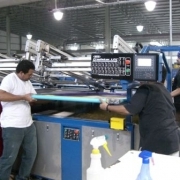
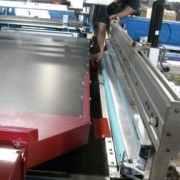
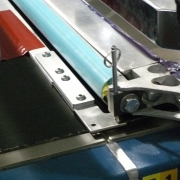
Once all the film positives and coated screens are pre-pinned for exposure, the screens are now press-ready for the Belt Press. A special Pin Bar is positioned and taped on the press belt to pin each frame to each other for quick and accurate set-ups. See right photo above showing the Pin Bar taped securely (red tape) to the belt and the frame is down in the print position. A stainless steel pin is then inserted through the frames corner PinLock at both top and bottom left corners and engages the Pin Bar underneath it for quick positioning and registration. The frame is then locked, lifted, and the Pin Bar is then indexed under the next frame and the pinning process is repeated. Once all the frames are pinned, the Pin Bar is removed from the belt and the job is ready for production. It's that simple.
Print summary:
Depending on the detail of the image, Newman Roller Mesh N166 or N205 was used for the underbase and N272 for all other colors at 52 Newtons using an M3I1N-UL Newman Roller Frame. The belt press was running at maximum speed, print was in perfect registration and color balance. Note: Another brand of mesh was also used at 25 and 35 Newtons but it did not hold the color balance throughout the production run compared to the Newman Roller Mesh at 52 Newtons. This project was for Nike in Honduras.
More photos of the Pin Bar and Newman Roller Frames below.
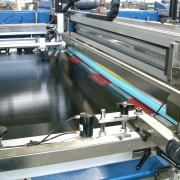
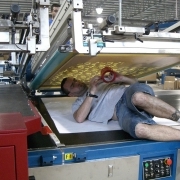
For additional information on the Belt Printer PinLock Registration System, contact us 800-523-3694. Or email us at info@stretchdevices.com.
